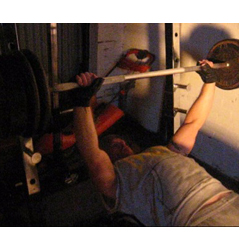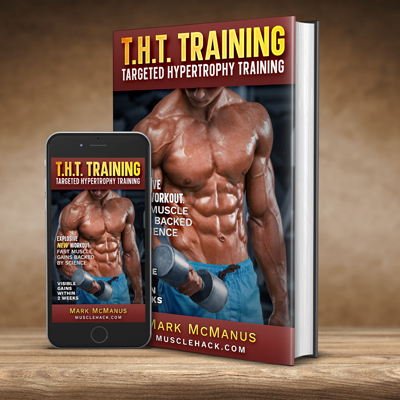 If you work out alone, you’re placing yourself at an increased risk of injury.
If you work out alone, you’re placing yourself at an increased risk of injury.
Some exercises like the bench press favor a spotter. Knowing you’ve got someone there who can assist you if you can’t complete your last rep puts your mind at ease.
Having said that, I work out alone. I’ve also never had a problem with the bench press or any other exercise for that matter.
Here’s some tips to help you bench press alone without putting yourself in harm’s way:
(1) Get to know your own body. This is the most important point; you should always know when you’re on your last rep. This comes with experience – train long enough and you’ll always know when you’re about to reach positive failure. You should never be attempting ‘the impossible rep’ when you know better.
(2) Use safety pins. I use a rack which comes with 2 sets of pins. One set for resting the bar on between sets, and another for setting at about chest height in case you get stuck. If you don’t have a full rack, a Multi Press Rack
or a Sumo Rack
will do nicely.
(3) Grab the bar where it feels most comfortable to you. Feeling comfortable means feeling strong. This means you’ll be less likely to get that weak feeling at the bottom of a rep.
(4) Wrap your thumbs around the bar. This makes it more likely that the bar will stay in your hands and not come crashing down on your chest. Some people use what’s called the ‘suicide grip’, which entails NOT wrapping your thumbs around the bar but keeping them underneath it throughout the movement. It’s called ‘suicide grip’ for a reason (see video below).
(5) Use gloves if necessary. If gloves feel good and give you a better grip, use them. This is a ‘personal preference’ issue, if you don’t like gloves, don’t use them.
(6) Lower the bar to the correct point. When flat benching, it is best to lower to a point just below the nipples. You’ll notice that you feel stronger here and again, less likely to get stuck a the bottom of the rep.
(7) Use smooth, fluid movements. Using jerky movements can cause a sharp pain to develop, especially around the elbows. If this happens on the pushing part of the rep, you can expect to lose strength faster than a speeding bullet. You might end up smashing some ribs instead of smashing your PR.
(8) If all else fails, do the ‘Roll of Shame.’ The roll of shame is when you admit a rep isn’t going to happen, lower the bar to your chest and roll it to your waist. Then you sit up, lift the bar and set it on the floor. It can be painful and it’s definitely embarrassing in a crowded gym, but it can also stop you doing yourself serious damage. (see second video)
example of what can happen with a suicide grip – warning, graphic content!
example of the ‘Roll of Shame’ (2nd attempt)
If you have any more tips, please share them with others below.
Mark McManus

It’s funny you made this article, I Just made a thread of this on bodybuilding.com forums about the same exact thing. You pretty much covered all the bases. I’m in the process of ordering a power rack as soon as my tax refund comes in. Only other thing I could add, would be to use dumbells instead of a straight bar for safety concerns, but it’s not the same to me. Great article.
Thanks iRobot. DB’s are fine up to a point, but once you start moving into heavy weights they become awkward to work with.
Get a power rack, you won’t regret it. 🙂
Mark
Mark,
Some nice tips. Especially #1. I gave it a Stumble as well.
Using the rack means you get push it and safely get that one extra rep. Well worth it.
Sorry, you CAN push it. Not “get”
thanks for the tips and the time n effort you put into your articles. i just discovered this website not long ago and its very helpfull.
I use dumbbells which is a good alternative for me.
Ya it’s funny until someone gets hurt. I see this kind of stuff everyday at my gym. The gym is located close to a high school. So we get all the superstars coming in. Just 2 days ago a kid I’ve never seen before and I doubt he’s ever seen a gym better sets up his bench with 45s and 25s per side not even secured he lies down flat bench and surely enough oooops there goes one side ooooops oh no the other side
#8? Roll of shame – this is a terrible piece of advice and can result in some major injuries. How can you even suggest this?
If you are working without a spotter then to not put plate holders / squeazers on your barbell – if the bar comes down on your chest let it rest there and then slowly tilt the bar to one side so that the plates slide off – hold the bar firlmly as it will “catapult” slightly to the other side as those weights fall off. then you take then end that is in the air and move it to behind you and you sit up. its that simple and controlled and no injury of a crushed / bruised rib cage or black and blue stomache.
Having to tilt the bar and let the weights slide off one side, then “catapault” off the other side is a sign that you have used too much weight or too many reps, and it’s a fantastic way to injure yourself. It’s just not safe to to this,I have had to do this on more than on e occasion while younger, and it’s embarassing.
Why risk an injury doing this and having to spend time not being able to train? Not recommended. Use a rack, or a spotter, a proper grip, and you won’t have to embarass yourself like this. I wouldn’t use the “roll of shame” for this reason either, I use a rack so I can push myself to failure in complete safety, with total confidence. I’m sure the author is suggesting this only as a last resort after making a mistake, why else would “shame” be in the title?
Exactly, Mark. Like I say early in the article, just use a rack. If you don’t have one, there’s no spot and you get in trouble, roll that thing off of you and hope no-one notices 😉
Hi Mark,
Thanks for addressing the training without a spot issues as requested! Whilst some of these are obviously common sense, it’s great to get tips and tricks off others. Personally, I’m using dumbbells for chest exercises rather than bench press at the mo – but the problem is i’m getting to a weight which is hard to get in to the starting position – so will be moving to bench press.
Keep up the good work!
Cheers,
Chris